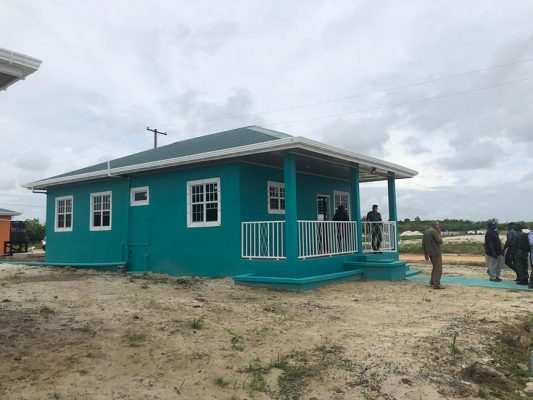President David Granger proclaimed yesterday morning that his government is moving to end homelessness and destitution, as he paid a visit to two housing schemes being developed for low and middle-income citizens.
Granger was taken on a tour of the Prospect and Perseverance housing schemes on the East Bank of Demerara, after which he addressed the residents of the latter, telling them that the country’s constitution mirrors declarations of the United Nations that say every citizen has a right to their own personal property, which include dwelling houses and “land on which they stand.”
“We are trying to create in Guyana a community of free citizens who own land, who own houses…We are trying to abolish homelessness, we are trying to abolish destitution. So our housing policy is embedded in international best practices,” Granger noted.

He stressed that adequate housing for citizens is an important facet of a good life and if one wants to improve the quality of life then the quality of housing must improve.
“So, in Guyana we have adopted a holistic approach to housing; not just to give you house lots and forget about you like a hit and run driver. We want to make sure that when an area is provided on which you would live, we develop that house so that we build a community,” Granger said, while emphasising that there is a need for adequate infrastructure such as roads and services.

He added that people must not just be provided with a “piece of land and grass” but should be provided with a place where they can enjoy life. He said that his government’s housing policy is not haphazard and has a clear purpose, which has resulted in them changing the orientation of the policy that was inherited to put more focus on low income earners.
“This government will provide for poor people as best as it could by making housing affordable. Without any apologies, we are focusing on middle and low income earners. We want to ensure that these communities have the resources so that people can live in comfort and safety,” he noted.
Granger also noted that the government’s policy will also focus on regularisation, as it is aiming to completely eradicate slums, shantytowns and squatter settlements, and he emphasised that public services need to be provided to every region and every capital town.
He said he is hoping that the policy of regionalisation benefits housing settlements beyond the coastland, and the administration will not neglect the rural or hinterland areas since regionalisation is to ensure equity of access.
Also giving an update on the progress of the two housing schemes, Chief Executive Officer of the Central Housing and Planning Authority (CH&PA) Lelon Saul related that the agency is currently “wrapping it up” at Perseverance and will only be constructing an additional 10 to 15 houses.
While there are 50 vacant lots left in the scheme, all have been allocated to persons, while a strip has been allocated for persons interested in establishing commercial activities in the areas, such as restaurants and supermarkets.
He said that there are a total of 571 house lots, with in excess of 412 housing units and that the CH&PA anticipates it will add a further 15.
“We had to give up about 20 house lots to allow for the connector road from the East Coast to the East Bank,” he said, while noting that the occupancy rate for the scheme is in excess of 70%, and for the ones that have not been occupied as yet, the beneficiaries are currently engaging the bank for mortgages and approval.
For the Prospect project, he noted that it would be conducted in three phases and it is currently in the first, where approximately 100 house lots were developed and 100 low income housing units built. Twenty lots will also be allocated to persons from Broad Street, and they expect within a month to come to an agreement with Food for the Poor for the construction of the houses.
“Within two months or so, we will move going to the west of Prospect, where an additional 138 housing units will be constructed and by the end of the year, we will go further west, adjacent to the public road, where approximately 538 house lots would be made available, along with commercial and industrial lots for investors,” he noted. Currently, one of the 400 square feet low-income housing units at Prospect costs $4 million, while those constructed with clay bricks from the Rupununi cost $3.5 million.
However, Saul noted that they were working to further bring the costs down by being able to procure a larger number of blocks.








